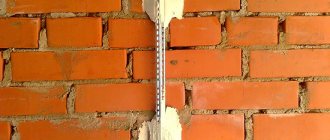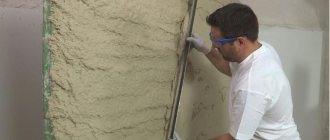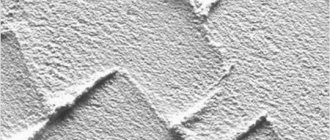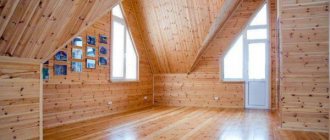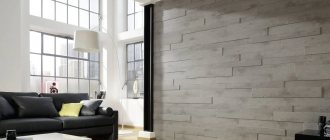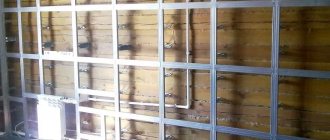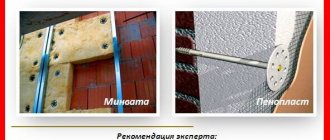Which plaster is best to use?
The primary issue that needs to be resolved before starting work is how to plaster the external and internal surfaces of the walls. Plastering brick walls is done using various dry mixtures:
- cement-sand;
- limestone;
- plaster;
- perlite.
Cement-sand mixtures
This is the optimal solution if you need to plaster walls for painting or wallpaper. Their recipe includes cement of various brands, sand, water (you can add additives, for example, frost-resistant ones). The mixture is universal. This type of plaster is used inside and outside the house. Rice. 1. Cement-sand mixtures The performance characteristics of plaster depend on the selected materials. Cement grades M150 – M300 are used only in mixtures for interior finishing. From M400 and above, for external facade work. If you prepare the solution yourself, you must strictly maintain the proportions of the components and use materials of the required quality. Otherwise, everything will have to be redone. It is undesirable to use fine sand for brick plaster, as it will be prone to cracking. The use of contaminated sand with various inclusions (soil, clay, etc.) also does not contribute to the necessary strength and durability. The optimal solution is to use river or quarry (after washing) with a fraction of 0.5-2.0 mm. Coarser grains increase the roughness of the outer surface of the plaster. Therefore, such sand is used for laying bricks or installing reinforced concrete structures. The advantages of the DSP include:
- long period of operation (if applied correctly), reaching 30 years;
- significant plasticity, achieved by long drying times (it is permissible to level the surface within several hours after finishing plastering);
- high resistance to high humidity allows the use of this plaster on external facades and when decorating bathrooms;
- resistance to sub-zero temperatures;
- fire resistance;
- environmentally friendly;
- versatility - no special equipment is needed for application.
Disadvantages include long periods of complete drying, the need for significant physical effort for application, and the importance of strict adherence to application technology. The material is quite heavy and does not have adequate resistance to shrinkage of the structure and vibration loads.
Lime mixtures
These solutions are divided into three subgroups:
- purely calcareous;
- lime-clay;
- lime-gypsum.
They are used for laying on walls that are not exposed to the negative effects of atmospheric factors (primarily precipitation) - indoors, closed loggias and balconies, interior partitions. To increase their strength and reduce setting time, building gypsum is added to the formulation. Rice. 2. Lime mixtures The total curing time is only 30 minutes, and the setting process begins already at 4 minutes. The average proportions of lime and sand are 1:3. A properly diluted mixture has a dough-like consistency. This group is considered budget. Advantages:
- vapor permeability;
- environmental cleanliness;
- bactericidal;
- durability;
- fire resistance;
- high adhesion to various substrates;
- versatility.
The disadvantages are:
- low resistance to moisture;
- slow development of design strength;
- cracking under vibration loads;
- weak, compared to other compositions, strength;
- When working, it is necessary to use protective equipment.
Gypsum plaster
It is a finishing material for work inside the house. Due to the high adhesion of the material, it is easier to work with. It is prohibited to add water to the prepared mixture, which has a rapid setting. This imposes certain restrictions on the volume of plaster that can be mixed at a time. The advantages of the material include:
- rapid development of design strength (up to 7 days);
- significant plasticity;
- environmental cleanliness;
- vapor permeability;
- low thermal conductivity;
- high adhesion;
- light weight;
- fire resistance;
- ease of grinding;
- maintainability.
Rice. 3. Gypsum plaster The disadvantages of the material are:
- low resistance to moisture;
- short service life;
- does not tolerate negative temperatures;
- easily affected by pathogenic microflora.
Perlite plaster
Perlites are sand with a coarse fraction obtained from obsidian. Visually, it resembles fine off-white crushed stone. It is a material for exterior finishing. The coating made from perlite plaster is very durable and differs in:
- high wear resistance;
- light weight;
- low thermal conductivity;
- fire safety;
- resistance to pathogenic microflora;
- acceptable vapor permeability.
Due to its characteristics, it can be used as an additional noise and heat insulator. Belongs to the category of “warm” finishes. The disadvantages include significant dust formation and technical difficulties in preparing the solution. The recipe includes:
- aggregate belonging to sponge class building materials;
- base – perlite;
- binder – cement, gypsum, lime;
- polymer additives – help to increase water-repellent properties, ductility, and air filling intensity.
All plastering materials discussed in this chapter can be made independently directly on the construction site. This reduces the cost of purchased materials. However, only using factory-made plaster from well-known manufacturers allows you to obtain a plaster coating of guaranteed quality. Read about other types of plasters in this article.
The best plaster mixtures
There are many different dry plaster mixtures from well-known brands on the market, the quality of which is not satisfactory. First of all, these are Ceresit and Knauf. In addition to them, it is worth noting the materials produced:
- (the entire Osnovit line, including dry mixtures for rough leveling (Startwell, Bigwell), finishing (Slimwell), decorative (Exterwell).
- Saint-Gobain group of companies (for example, mixtures of the Weber-Vetonit line).
- Brands Bolars and Kiilto, Glims and Unis.
What is the best way to plaster white brick?
To plaster walls made of silicate (white) brick, a layer of mortar of 20 mm or more is applied. This is due to the fact that this type of brick is not resistant to moisture. In order for the plaster to last as long as possible, the solution must be made from:
- Asbestos;
- Sand;
- Cement.
Since the surface of sand-lime brick is perfectly smooth, the mortar sticks to it for quite a long time.
In general, lime-cement plaster is a good choice for plastering white brick as it works well when applied in thick layers. However, this type of plaster is not sufficiently resistant to dampness. Adhesion to the base is the same as that of cement-sand plaster, so the use of additives is necessary.
Before plastering with lime-cement mortar, the surface must be cleaned and oil stains removed.
Please note that it is imperative to use a metal reinforcing mesh for any type of plastering.
Nowadays, gypsum plaster is also used for plastering sand-lime bricks. It allows you to create a fairly smooth surface due to its elasticity. This plaster is applied in the same way as in the previous case, only it is leveled using the h-rule using zigzag movements.
If it is necessary to apply another layer, the first one is “combed” using a plaster comb, after which it is allowed to dry. Only after this can you begin re-plastering. When the surface has a more matte shade, it additionally needs to be smoothed using a metal smoother or spatula. After this, you can paint the surface or start gluing wallpaper.
Cement-sand plaster is quite common in the modern construction market. It is characterized by:
- Increased moisture resistance;
- High quality of the applied layer;
- Possibility of manual and mechanical application;
- Long shelf life.
This plaster can be used to level silicate brick walls. The main disadvantage is the high specific gravity, which is why a layer thicker than 5 centimeters can lead to peeling. To improve adhesion, modifiers are added to the finished dry mixture.
Below are the materials and tools that will be useful to you for plastering walls made of sand-lime brick:
- Cement, lime and sand;
- Primer;
- Rule;
- Master OK;
- Level;
- Net;
- Brush;
- Dowels;
- Concrete mixer;
- Putty knife;
- Grater and sandpaper.
Necessary tool for plastering bricks
Rice. 4. Minimum set of tools for plastering brick An experienced finisher’s list of tools includes up to 30 items. Let us mention the minimum set of tools, without which it is impossible to work. These include:
- The trowel, which is used to mix the working mixture during its preparation, is applied to the wall and leveled. These operations are also performed with a set of spatulas or a falcon.
- An electric drill (perforator) with a mixer is convenient to use for preparing the solution.
- “Semi-grater” (oval or standard) for drawing out corners.
- A smoothing board, a spray bottle (brush), a building level (preferably a laser), usually a plumb line, a tape measure for leveling surfaces.
- Bubble level rules. For small ones, up to 1.5 m, the plaster is leveled. Large checks the quality of application (horizontal, vertical).
Installation
The plaster is applied according to the usual scheme.
Now we will tell you how to plaster sand-lime brick with your own hands (see also the article “Plaster for gas silicate blocks - features of this type of material and rules for working with them”).
To do this, our specialists have compiled step-by-step instructions:
- We put the wall in order: we remove the old finish, repair cracks, clean the surface from dirt and dust and apply a deep penetration primer to it;
We put the wall in order and prime it.
- We take a steel plaster mesh and stuff it onto the wall using dowels with wide heads. We make at least 20 fastenings per square meter of wall area;
We stuff the plaster mesh.
- On the sides of the wall, at a distance of 30 cm from the corners, we drive in dowels and make plumb lines. Then we connect the upper and lower pairs of dowels with horizontal threads and adjust them so that the minimum distance to the wall is at least 20 mm. We also mark the diagonals of the resulting rectangle with threads and ensure that they slightly touch, but the vertical position of the plane corresponds to the plumb lines;
The minimum distance to the wall is at least 2 cm.
- We leave the upper and lower threads taut and place beacons along them. To do this, we mount pieces of a metal profile or rod on the wall along the entire height in increments of 150 cm, the distance to the edges is 30 cm. We fix the profiles with cement mortar;
We install beacons from the profile.
- We prepare a plaster mortar from cement and sand in a ratio of 1:5, you can also add one part of slaked lime or asbestos. When the beacons have dried, we throw the solution with a ladle onto the surface between two adjacent profiles; when a portion of the solution hits the wall, a characteristic slap should sound;
Apply the mortar with a plaster ladle.
- When the gap is filled, we apply the rule from bottom to top along the beacons, removing the excess layer and distributing it over the surface. The main task is to form the main layer with a flat plane; the quality of the surface is not the main thing now;
Align the layer according to the beacons using the rule.
- When the wall is completely covered, wait at least 7 hours for the solution to set. After this, carefully pull out the beacons;
Traces from beacons are easy to cover up.
- We take a plaster float and apply the solution to the surface like putty, while rubbing it into the wall in a circular motion until a smooth, uniform surface is obtained. There should be no flaws or irregularities left.
We carry out the final grouting of the walls.
Important! It is not advisable to build up a layer during grouting, so in some places you can simply wet the surface and rub its coating until it is even.
Preparing a brick wall for plastering
It is allowed to begin plastering work on a house after the completion of shrinkage of the structure and completion of a set of installation and general construction work related to the walls (laying wiring, pipelines, installing door and window frames). They begin with the stage of inspecting the surface of brick walls and determining how smooth the surface is. Based on this information, the expected consumption of materials for their preparation and plastering is calculated. The work algorithm is different for new and old walls. In the first case, to prepare them, you need to perform the following activities:
- general cleaning (removing dust, grease stains, dirt, undoing seams, cleaning identified cracks);
- surface treatment with bioprotective impregnation;
- wire brushing for better adhesion to the plaster.
In the second, the list of upcoming works depends on the actual condition of the wall:
- the old coating is removed;
- identify and fix (replace) loose bricks;
- repair chips and cracks;
- remove the remaining elements of the metal fasteners.
How to plaster a brick wall
Let's take a step-by-step look at the main stages of the work.
Preparation of plaster mortar
The quality and durability of the applied layer of plaster depends on proper preparation:
- when working with ready-made dry mixtures, they are diluted taking into account the manufacturer’s recommendations (instructions are given on the packaging);
- if you plan to determine the proportions yourself, you should take into account the upcoming operating conditions and the consequences of errors in adding components.
Example. If there is an excess of binder, a greasy paste-like solution is obtained. It is characterized by increased consumption and a tendency to surface cracking when drying. A lack of binder makes the paste thin and significantly reduces its strength. Rice. 5. Preparation of plaster mortar You can mix the components by hand (with a shovel or electric drill with a mixer) or in a mortar mixer (for a team of several plasterers and a large volume of work).
Surface priming
This step is mandatory. Performed immediately after the preparatory one. This is explained by the high porosity of the brick, which absorbs water from the applied finishing material. As a result, the strength of the latter drops by almost half. The choice of primer type is associated with an assessment of the following factors:
- The degree of porosity of the brick from which the masonry is made. For silicate, a mixture with increased adhesive properties is better suited. For medium-density bricks, a universal primer is recommended.
- The initial state of the surface (for old masonry it is necessary to choose a deep penetration soil).
- Places of application (facades, rooms with high humidity are treated with moisture-proof mixtures with antiseptic capabilities).
The optimal solutions are materials based on silicone or acrylic (water-soluble universal). It is recommended to apply the primer in two or three layers, applying them by hand (brush or roller) after the previous one has completely dried.
Reinforcement
Reinforcement increases the strength of the coating. When performing this, a reinforcing mesh with a cell size of 10*10 is used:
- fiberglass - under plaster for interior work;
- metal - on facades and when simultaneously processing large areas (as a rule, it is pre-treated with a protective varnish);
- PVC mesh is not used for applying DSP.
The mesh must be installed after the soil has dried. It is coated on both sides with mortar, which eliminates contact with the surface of the brick. Stretch it overlapping in place, fix it with self-tapping screws, nails or special hooks (fastening pitch, 250 mm). Fixation is carried out without tension, without sagging and the formation of mesh bubbles.
Installation of beacons
Lighthouse profiles are commercially available. The installation of beacons is carried out according to the following algorithm:
- the most convex point on the wall surface is determined (the location of the wall plane after applying the plaster layer is determined using it (screws, plumb line), installed beacons must exceed it in height by 5 mm);
- Marking of beacon installation sites is carried out (step 600-1000 mm);
- the two outermost ones are set (indented from the corner by 300 mm);
- The plane is set with a nylon cord and the remaining beacons are mounted on the solution (it is recommended to pre-cut them to the required length).
Applying layers of plaster mortar
Rice. 6. Applying and leveling the plaster mixture When working independently, you should consider a few simple recommendations:
- the solution is mixed in a volume that the master is able to produce without losing its plasticity in an hour;
- the prepared solution should stand for 5-10 minutes (“rest”) before using it;
- The plaster solution is applied to the surface of the brick wall in three layers.
Before applying plaster in an apartment or private house, it is recommended to wet the surface of the wall. The spray is applied first. This is a material that has the consistency of liquid sour cream. Direction of application: bottom left – top right. The composition is applied in blocks (between two adjacent beacons). The thickness of 1 layer is 4-5 mm. after 3-4 minutes, areas that strongly protrude beyond the beacons are cut off or smoothed. There is no need to level it (the option of applying a layer by spreading is possible). The second layer is soil. The consistency of the mixture is doughy. Apply after the previous layer has dried. Thickness – up to 20 mm. The casting is carried out in the places of the recesses left after the first pass. The alignment is performed by the rule. 3-4 times from bottom to top, then from top to bottom once (this reduces the likelihood of the mixture running off). The solution is again added to the remaining recesses. And the work is repeated as a rule. The third layer is the covering. It is not required. The solution becomes quite liquid. Application thickness up to 2 mm. The covering is leveled with a trowel. If the estimated thickness of the plaster layer exceeds 30 mm, it is more economically feasible to use plasterboard sheets for interior finishing. After the plaster has set, the beacons should be removed and the remaining traces should be sealed with putty.
Finish grout
The final grouting of the surface is carried out with a float. First pass, in a circular motion. The second is vertical alignment. Tritium - horizontally. If plastering for wallpaper or painting is carried out, the surface is additionally sanded.
Plastering walls depending on the type of material itself
Plaster shingles: a - intertwined shingles, b - location of reed and exit shingles.
When plastering walls made of sand-lime brick, you need to apply a layer of mortar of at least 20 mm, since this brick is not resistant to moisture. In order for the plaster to last a long time, the solution must be made of sand, asbestos and cement. Since sand-lime brick is very smooth, the mortar sticks to it for a long time.
The advantage of lime-cement plaster is the ability to apply it in a thick layer. However, this type of plaster is not resistant to dampness, and the adhesion to the wall surface is the same as that of cement-sand plaster, so the use of additives is also necessary. Before you start plastering with lime-cement mortar, the surface must be cleaned and removed from oil stains. A prerequisite for any type of plastering is the use of reinforcing metal mesh.
To plaster the wall, wooden or metal beacons are used; if the wall is uneven, wedges are placed under the beacons in such places.
The solution is applied evenly to the wall using a trowel or ladle in a semicircular motion. The solution layer should be about 2 mm. Then we level the surface using the rule. When the plaster has dried slightly, we grout it with a wooden or foam float. To obtain a high-quality plastered surface, it is recommended to protect it from drying out for the first three days after applying the solution. If the weather is hot, the applied coating should be moistened periodically.
In recent years, gypsum plaster has also been successfully used for walls. It allows you to create a fairly smooth surface due to its elasticity. This plaster is applied in the same way as in the previous case, only it is leveled using the h-rule using zigzag movements. If you need to apply another layer, then the first one is “combed” using a special plaster comb and allowed to dry. Only after this can you plaster again. When the surface acquires a matte tint, it is additionally smoothed with a metal trowel or spatula. Next, the surface can be painted or wallpaper glue applied.
Tool for plastering walls.
Cement-sand plaster is very common. It is characterized by increased moisture resistance and good quality of the applied layer. It is used for both manual and mechanized application. Cement-sand plaster is used to level silicate brick walls. The disadvantage of such plaster is its high specific gravity, so if the layer is more than 5 cm, it threatens to peel off. To improve adhesion, special additives are added to the finished dry mixture. You need to plaster as described above.
Tools and materials you may need:
- sand, lime, cement;
- primer;
- net;
- dowels;
- brush;
- concrete mixer;
- rule;
- level;
- Master OK;
- grater or sandpaper;
- putty knife.
In conclusion, I would like to say that sand-lime brick is an excellent universal wall material.
Features of plastering external walls
The difference between performing external work is the same:
- the entire surface must be reinforced with metal mesh;
- when plastering external facades, it is recommended to use a cement-sand mixture;
- the corners of the building and slopes are fixed with special perforated plastic corners (their unique reinforcement is performed);
- total permissible thickness of the applied plaster layer ≤ 15 mm;
- Before covering, the previous layer is primed twice.
For other positions, the technology for carrying out work from the outside and inside is the same.
What is the best way to plaster external facades?
Exterior finishing is carried out only with DSP or cement-lime mixtures. In areas of efflorescence, sanitizing mixtures are used. Finishing may involve the use of decorative plaster, both universal and purely facade. Plinths are plastered only with DSP.
Important nuances of brick plastering
Rice. 7. Plastering the external wall of a house In cases where the applied layer has a significant thickness, it is applied in several stages (with a thickness of each layer ≤ 5 mm), with mandatory reinforcement. The intermediate layers may not be leveled. The maximum permitted thickness of the plaster layer cannot exceed 100 mm. at the same time, the probability of its delamination and shedding increases significantly. The optimal thickness is considered to be up to 50 mm. Acceptable environmental parameters for plastering brick walls are temperature (5-35) °C, humidity ≤ 65%. The electrical wiring is de-energized, the recesses for installing switches and sockets are covered with masking tape. They also protect door (window) trims.
- It is recommended to add quicklime (calcium oxide) to self-prepared solutions for exterior finishing.
- In order to increase the thermal insulation properties of the plaster, porous substances (pumice, sawdust, analogues) are added to the solution.
- It is strictly forbidden to dry the plaster with a hairdryer or other means. This will lead to cracking.
Sand-lime brick
Composition and features
The photo shows the most typical type of sand-lime brick.
Sand-lime brick differs in composition, which determines its main features ().
This material consists of the following components:
- Quartz sand. It makes up about 90% of the product’s weight and is a natural, environmentally friendly raw material;
- Air lime. The second main component of the mixture from which the brick is pressed is also an absolutely harmless and clean product from the point of view of the presence of toxins and other undesirable impurities;
- Alkali-resistant and weather-resistant pigments. They are added to color the finished product; mostly safe artificial dyes are used.
Using pigmentation they create a wide range of colors.
This simple mixture is pressed dry, creating the shape of the product, and then the block is autoclaved at a water vapor temperature of about 200 degrees and a pressure of about 8 - 12 atmospheres (autoclave synthesis), which results in a durable and smooth sand-lime brick.
The advantages of this type of brick include the following features:
- A smooth, high-quality white surface allows you to build smooth, beautiful walls;
- Environmentally friendly composition. The material is completely safe and consists of natural ingredients;
- Good sound insulation properties make it possible to successfully use the material not only for the construction of external enclosing structures, but also for the construction of interior and apartment partitions;
- High strength and reliability allow builders to guarantee 50 or more years of normal operation of facades made of this material;
- Good frost resistance makes it possible to use sand-lime brick in the Russian climate;
- Unpretentiousness to external conditions. Surfaces made of silicate material retain their integrity and beauty for a long time;
- Relatively low price.
The material allows you to build smooth, high-quality walls.
There are also disadvantages: fear of moisture and high temperatures. Because of these shortcomings, this type of brick is not used in the construction of wells, foundations, furnaces, pipes and tanks. In other areas of construction, the material is used very widely due to its properties and availability.
Important! Sand-lime brick consists of a fine filler, therefore it has a higher density compared to ceramic brick, as well as a smoother and less porous surface.
Plastering
Some features of the material affect the technique of plastering it.
There are two features of sand-lime brick that most influence the approach to applying plaster to its surface:
- Smooth and dense texture. Because of this structure, the solution does not adhere well to the material, so during the plastering process, a reinforcing steel mesh must be used, which is firmly fixed to the wall with dowels, and also one cannot do without priming;
- Fear of water. As a result, the protective plaster layer must be thicker, which, together with poor adhesion of the solution to the surface, complicates installation, extends the work time and increases its labor intensity and cost.
Manual and mechanized plastering
The manual application technology was discussed in detail above. There is another technology that is optimal for a large surface area of brick walls - mechanized.
Algorithm for performing work with mechanized plastering
The preparatory stage is similar. After its completion, a team of plasterers installs a plastering station at the work site and connects it to water and power sources. The dry plaster mixture of the selected brand is loaded into the hopper. From there, the material is fed by a screw into the mixing chamber, where it is mixed with water. The continuity of the feeding and mixing process guarantees the homogeneity of the resulting mixture. The plaster is applied to the wall at an angle of 90° through a special nozzle mounted on the supply hose (the shape of the nozzles can be changed). Rice. 8. Mechanized plastering of brick walls The process is completed after the beacons are closed. The finishing is done manually.
Advantages of machine application
Mechanical mixing produces a high-quality plaster mixture with a high content of air bubbles. This increases the volume of the solution while reducing its weight. The savings in raw material are quite significant. Consumption is approximately 16 kg/m2 (at 35-45 for the manual version). The finished composition is homogeneous. Other advantages of mechanized plastering are that:
- The plaster is applied to the entire surface almost at the same time, which eliminates the “scale effect”.
- The time required to complete the work is reduced by more than 2 times and the quality of the finished wall surface is improved (more suitable for applying finishing materials: painting, wallpaper, tiles).
- Two technological stages are performed simultaneously - leveling the wall and putting it on. Up to 200 m2 of surface is processed per shift.
- A lower cost of plastering is achieved.
Joining the wall
So, the first way is to line the wall, or rather the applied decorative plaster, to look like bricks. To do this, you need a tool suitable for use (the handle of a paint roller, a special tool for carving plaster, a knitting needle, a stick). This method is suitable for both small and large areas. If the master has experience in this matter, then this method of creating brickwork will be the fastest.
Drawing the bricks should be done on already set worn decorative plaster. If you show your imagination, you can make the “brick” decor very original and unusual. For example, do not make the bricks perfectly even, but on the contrary, experiment with the size, their texture, and location. A dry, hard brush will add texture to the brickwork.
Using construction tape
Another popular way is to imitate such decor using special construction tape. This takes a little practice. After all, the repair technology itself consists of gluing a narrow mounting (insulating) tape or a ready-made rubber or polymer stencil onto a previously prepared surface. The ends of this stencil should protrude beyond the marked plastered area. When the applied layer dries, the stencil (tape) is carefully undermined. This is how the pattern of their seams remains on the wall.
This method is the best for creating textured relief. But at the same time, a lot of time is spent on gluing the tape and carefully detonating it. Moreover, additional effort needs to be spent on “repairing” the texture of the bricks.
Using a template
Imitation of brickwork can also be done using a template. As such, you can use almost all suitable objects, for example, molds made of hard materials such as wood or plastic. The solution must be applied between the guides of this solid template. There are also hybrid versions of templates, for example, on the outside there is a wooden frame, on the inside there is a mesh made of mounting tape. Such a template will not be huge in size, as it will be inconvenient to use. Alternately moving the template from place to place, the master goes through the entire wall row by row. The disadvantage of this method is that when the frame is torn from the wall, the shape of the bricks may be damaged. Although some may like this decor idea.



